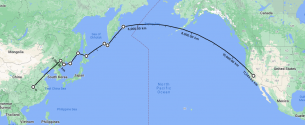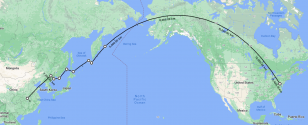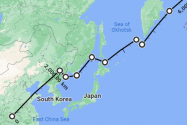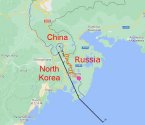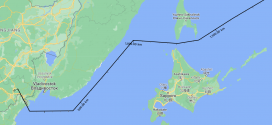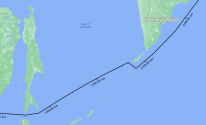I believe that others in this thread have already provided their answers (in light of recent geopolitical events, that is), so I wouldn't dive any deeper WRT the geopolitical front.
However, assuming that Moscow somehow really gone through a change of heart, and decides to not become so chummy with Beijing anymore. This could set the foundation for Russia to become strictly neutral in the US-China conflict. In that case, there are two scenarios where things can play out, where both scenarios are double-edged swords for both China and the US:
Scenario 1 - Russia stops neither China's H-20 nor US's B-21 from crossing over its territorial airspace other than lodging complaints.
In that case, China could either try to pressure Russia to intercept US B-21s from flying over their airspace (with varying guarantee of success, depending on Moscow's leaning at the time), or that China would rely on their own radars, interceptors and SAMs to detect and intercept the B-21s. Despite this, if Russia does not do anything to stop the US B-21s, then they wouldn't do the same with China's H-20s as well.
Scenario 2 - Russia intercepts both the US B-21s and China's H-20, and warned that the Russian Air Force would shoot them down if they keep violating Russia's neutrality.
In that case, China would have no choice but for their H-20s to deviate around Russia's territorial airspace in their strategic bombing runs against CONUS. One plus for China would be that the US B-21s would have no choice but to take the longer route across the Pacific in order to avoid Russia as well.
In short, Scenario 1 would be the less risky for the H-20s, but would be more challenging for China's stance and maneuvering in the global geopolitical stage. Meanwhile, Scenario 2 would the be less challenging for China's stance and maneuvering in the global geopolitical stage, but it more risky for the H-20s.
But let us go deeper. Assuming that China is facing Scenario 2 where H-20s are barred from entering Russian territorial airspace, and similar to my previous example, the H-20s are based in an airbase somewhere within China's interior. The following would be the shortest routes that the H-20s could take to CONUS.
If the intended targets are on the West Coast of CONUS:
View attachment 102981
If the intended targets are on the East Coast of CONUS:
View attachment 102982
Compared to the direct routes across Russian Far East or Siberia, the two routes above are certainly longer and would be more exposed to interception by American, Canadian and Japanese forces along the First Island Chain, while bypassing the Second Island Chain completely. Taking these routes would also necessitate refueling the H-20s mid-journey. For conducting bombing runs on the East Coast of CONUS, those H-20s would have to enter Alaskan and Canadian airspaces to launch their payloads, even if those are ultra-long-range standoff missiles.
The reason lies in the first half of both flight routes:
View attachment 102983
The H-20s would have to fly along the north side of the China-North Korea border first, until right before the China-Russian border where the H-20s would make a sharp turn towards the southeast and fly parallel to the China-Russia border. And here's the quirk:
View attachment 102987
The China-North Korea-Russia tri-border meetpoint (illustrated by the pink dot) is located just 18 kilometers from the coast.
This means that China's H-20 can fly across the China-North Korea border and parallel to the North Korea-Russia border towards the Sea of Japan, before turning northeast and fly parallel to the Russian coastline. By doing this, China would also intrude North Korean airspace and fly over the town of Tumangang without entering Russian airspace.
Why North Korea? There are 4 reasons:
1. Beijing, being the powerful supporter & backer of the Kim's family rule for the past 7 decades, would have a greater political leverage against Pyongyang than Moscow. This means that compared to Moscow, it would be easier for Beijing to turn Pyongyang's eyes elsewhere for the H-20s to pass through;
2. The length which spans from the China-North Korea border near the tri-border meetpoint to the endpoint of North Korea-Russia maritime border is only 58 kilometers. The H-20s would only take less than 4 minutes to travel the entire length, assuming that H-20 has the same crusing speed as the B-2 (900 km/h). That distance can be shortened even further if the H-20s coudl fit through that tiny strip of land between North Korea and Russia (shaded in orange);
3. The North Korean military are much more backward and outdated compared to their Russian and Chinese counterparts. This fact is well understood by everyone in the North Korean military watching space. Because of this, even if they know that China's H-20 is intruding their airspace illegally, Pyongyang would have a greater leverage of deniability than Russia by claiming that China's H-20 is "too advanced and too stealthy" for their own (North Korean) radars to detect; and
4. China already has a mutual defese treaty with North Korea from 1961. If Beijing and Pyongyang are worried that the US and her allies may use North Korean airspace to enter China with their warplanes, China can provide assistance by providing early warning radar support and relaying alerts to North Korea, then letting the KPAF warplanes/SAMs to intercept them.
After leaving the North Korean airspace, the H-20s would travel northeastwards along the Russian coastline over the Sea of Japan. Then the H-20s would turn east just before the southern regions of Sakhalin Island:
View attachment 102988
In fact, this would be the riskiest part in the first half of the journey. The H-20s have to squeeze across this "bottleneck" Soya Strait between the northern tip of Hokkaido and southern tip of Sakhalin before turning northeast again across the Sea of Okhotsk. I'd have to count on luck for this traverse. If the forces stationed in northern Japan are attempting an intercept, the H-20s can turn towards the Sakhalins.
After passing through Soya Strait, the H-20s would continue travelling towards the northernmost opening between the Kuril Islands, the Fourth Kurilsky Strait:
View attachment 102989
The H-20s would squeeze across the strait before continuing their journey towards CONUS across the Bering Sea.
Once the bombing run is done, the H-20s would backtrack along the same path back to their home bases in China.
I hope this answers your question.

